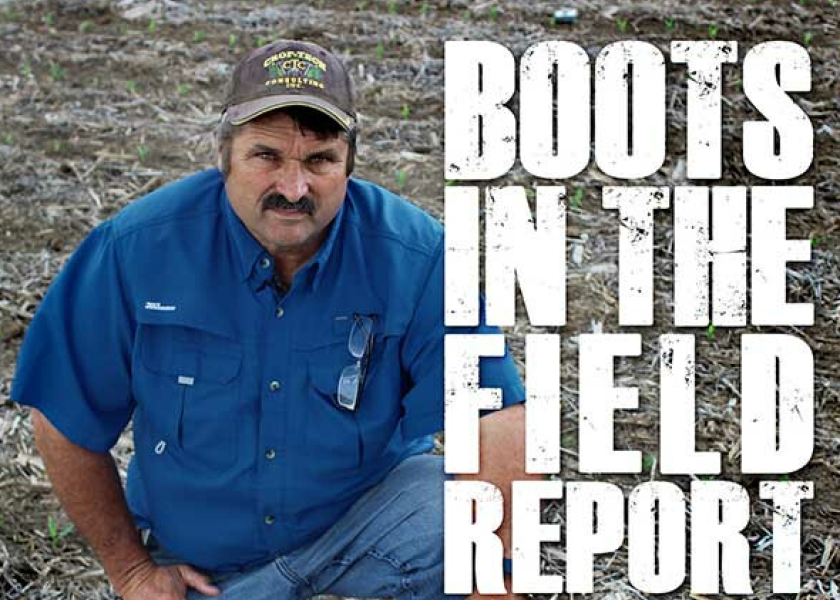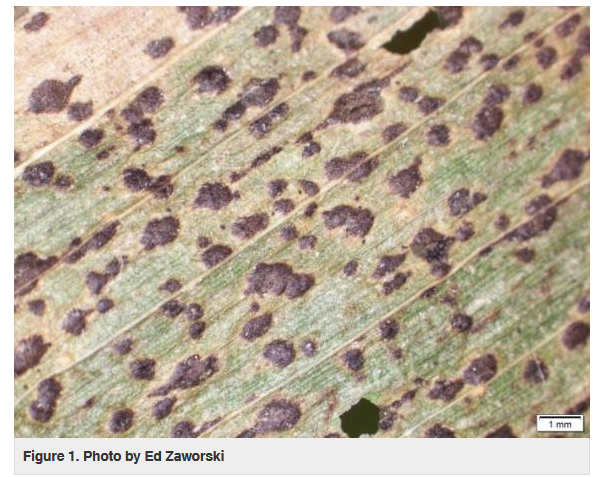Ferrie: Severe Tar Spot is Shutting Down Corn, Encouraging Top Leaf Dieback

Tar spot has a strong foothold in some cornfields across parts of central Illinois, according to Ken Ferrie, Farm Journal Field Agronomist.
Until this past week, he had difficulty determining whether or to what degree fungicide applications had kept the problem in check.
“I can finally see the areas in fields where airplanes couldn’t get in and spray because of obstructions, and those unsprayed areas are flat out exploding with the disease and bringing that corn to a halt,” he reports.

Along with tar spot, he also reports seeing gray leaf spot, northern corn leaf blight and southern rust in cornfields.
A domino effect. The heavy disease pressure, particularly from tar spot, is now allowing anthracnose to move into corn and cause top leaf dieback.
“It’s when those top two leaves die versus how the corn plant normally dies from the bottom up,” Ferrie says. “In this case, you’ll start to see the top two leaves are dead while the middle of the plant is still green.”
Top leaf dieback can also result from factors other than anthracnose, including drought and insect damage.
Ferrie adds that while there is no fungicide on the market that controls anthracnose top leaf dieback, a fungicide applied earlier for other disease concerns can often slow dieback enough that it doesn’t become a significant, yield-affecting disease.
“We’ll probably determine that some of these fields should have been sprayed twice, especially those fields that got sprayed early,” he says. “How much loss we’re going to be looking at will be tied to where ear development was when the plant started to shut down and make a run for that finish line.
“I do believe our later-planted D hybrids – those that get a lot of their horsepower from depth – will have the most to lose

Those fields with heavy disease pressure that were not sprayed with a fungicide are unlikely to produce a high yield or what could have been a record yield. Now, they are most likely to produce an average to slightly above average crop.
“At best, those fields will still produce a good crop but without a fungicide application, we probably left money on the table,” Ferrie says.
Next steps now. Ferrie advises farmers to check various hybrids to get a sense of which ones are doing the best job of handling tar spot.
“Grab the same leaf off each hybrid and put them side by side and look for the ones that are doing the best job of handling tar spot,” he encourages.
While the disease is fairly widespread in Illinois this year, Ferrie says the heaviest pressure he’s seen is along Highway 136 and north of there.
“If you find hybrid numbers that look to be doing exceptionally well with tar spot among varieties that are getting shut down by it take note and give me a heads-up as well,” he says. “We need to see if we can find some hybrids out there that are making a difference.”
There are no hybrids offering complete resistance to tar spot, but partial resistance in some hybrids is available. Ferrie encourages farmers, whose corn is hit hard by tar spot this season, to talk with their seedsman about the issue and how to plan their seed selection process for 2022.
In this week’s Boots In The Field, Ferrie also provides an overview of corn and soybean development in Indiana and Ohio. Learn more here:
Ferrie: Southern Rust is in some Illinois Corn at R4 Stage, 30 Days from Finish Line
Talking Technology: Ferrie Says This Investment Can Yield Up to $100/Acre Profits
Ferrie: Consider Yield Maps as Highly Valued Game Tapes to Review







